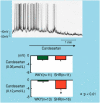Importance of rostral ventrolateral medulla neurons in determining efferent sympathetic nerve activity and blood pressure
- PMID: 22170390
- PMCID: PMC3273996
- DOI: 10.1038/hr.2011.208
Importance of rostral ventrolateral medulla neurons in determining efferent sympathetic nerve activity and blood pressure
Abstract
Accentuated sympathetic nerve activity (SNA) is a risk factor for cardiovascular events. In this review, we investigate our working hypothesis that potentiated activity of neurons in the rostral ventrolateral medulla (RVLM) is the primary cause of experimental and essential hypertension. Over the past decade, we have examined how RVLM neurons regulate peripheral SNA, how the sympathetic and renin-angiotensin systems are correlated and how the sympathetic system can be suppressed to prevent cardiovascular events in patients. Based on results of whole-cell patch-clamp studies, we report that angiotensin II (Ang II) potentiated the activity of RVLM neurons, a sympathetic nervous center, whereas Ang II receptor blocker (ARB) reduced RVLM activities. Our optical imaging demonstrated that a longitudinal rostrocaudal column, including the RVLM and the caudal end of ventrolateral medulla, acts as a sympathetic center. By organizing and analyzing these data, we hope to develop therapies for reducing SNA in our patients. Recently, 2-year depressor effects were obtained by a single procedure of renal nerve ablation in patients with essential hypertension. The ablation injured not only the efferent renal sympathetic nerves but also the afferent renal nerves and led to reduced activities of the hypothalamus, RVLM neurons and efferent systemic sympathetic nerves. These clinical results stress the importance of the RVLM neurons in blood pressure regulation. We expect renal nerve ablation to be an effective treatment for congestive heart failure and chronic kidney disease, such as diabetic nephropathy.
Figures









Comment in
-
Does angiotensin II cross the blood-brain barrier?Hypertens Res. 2012 Jul;35(7):775. doi: 10.1038/hr.2012.55. Epub 2012 Apr 26. Hypertens Res. 2012. PMID: 22534521 No abstract available.
Similar articles
-
Excess dietary salt alters angiotensinergic regulation of neurons in the rostral ventrolateral medulla.Hypertension. 2008 Nov;52(5):932-7. doi: 10.1161/HYPERTENSIONAHA.108.118935. Epub 2008 Sep 8. Hypertension. 2008. PMID: 18779436 Free PMC article.
-
Role of angiotensin-(1-7) in rostral ventrolateral medulla in blood pressure regulation via sympathetic nerve activity in Wistar-Kyoto and spontaneous hypertensive rats.Clin Exp Hypertens. 2011;33(4):223-30. doi: 10.3109/10641963.2011.583967. Clin Exp Hypertens. 2011. PMID: 21699448
-
Angiotensin-(1-7) enhances the effects of angiotensin II on the cardiac sympathetic afferent reflex and sympathetic activity in rostral ventrolateral medulla in renovascular hypertensive rats.J Am Soc Hypertens. 2015 Nov;9(11):865-77. doi: 10.1016/j.jash.2015.08.005. Epub 2015 Aug 20. J Am Soc Hypertens. 2015. PMID: 26428223
-
Role of the caudal pressor area in the regulation of sympathetic vasomotor tone.Braz J Med Biol Res. 2008 Jul;41(7):557-62. doi: 10.1590/s0100-879x2008000700002. Braz J Med Biol Res. 2008. PMID: 18719736 Review.
-
Medullary and supramedullary mechanisms regulating sympathetic vasomotor tone.Acta Physiol Scand. 2003 Mar;177(3):209-18. doi: 10.1046/j.1365-201X.2003.01070.x. Acta Physiol Scand. 2003. PMID: 12608991 Review.
Cited by
-
Sexual dimorphism in rats exposed to maternal high fat diet: alterations in medullary sympathetic network.Metab Brain Dis. 2021 Aug;36(6):1305-1314. doi: 10.1007/s11011-021-00736-1. Epub 2021 Apr 29. Metab Brain Dis. 2021. PMID: 33914222
-
Ischemia and reactive oxygen species in sympathetic hyperactivity states: a vicious cycle that can be interrupted by renal denervation?Curr Hypertens Rep. 2013 Aug;15(4):313-20. doi: 10.1007/s11906-013-0367-y. Curr Hypertens Rep. 2013. PMID: 23754326 Review.
-
Pacemaking Property of RVLM Presympathetic Neurons.Front Physiol. 2016 Sep 22;7:424. doi: 10.3389/fphys.2016.00424. eCollection 2016. Front Physiol. 2016. PMID: 27713705 Free PMC article. Review.
-
Role of peripheral vestibular receptors in the control of blood pressure following hypotension.Korean J Physiol Pharmacol. 2018 Jul;22(4):363-368. doi: 10.4196/kjpp.2018.22.4.363. Epub 2018 Jun 25. Korean J Physiol Pharmacol. 2018. PMID: 29962850 Free PMC article. Review.
-
Renal autonomic dynamics in hypertension: how can we evaluate sympathetic activity for renal denervation?Hypertens Res. 2024 Oct;47(10):2685-2692. doi: 10.1038/s41440-024-01816-2. Epub 2024 Aug 2. Hypertens Res. 2024. PMID: 39095482 Review.
References
-
- Julius S, Jamerson K. Sympathetics, insulin resistance and coronary risk in hypertension: the chicken-and-egg question. J Hypertens. 1994;12:495–502. - PubMed
-
- Esler M, Lambert G, Brunner-La Rocca HP, Vaddadi G, Kaye D. Sympathetic nerve activity and neurotransmitter release in humans: translation from pathophysiology into clinical practice. Acta Physiol Scand. 2003;177:275–284. - PubMed
-
- Esler M. The 2009 Carl Ludwig Lecture: pathophysiology of the human sympathetic nervous system in cardiovascular diseases: the transition from mechanisms to medical management. J Appl Physiol. 2010;108:227–237. - PubMed
-
- Guyenet PG. The sympathetic control of blood pressure. Nat Rev Neurosci. 2006;7:335–346. - PubMed
-
- Lucini D, Mella GS, Malliani A, Pagani M. Impairment in cardiac autonomic regulation preceding arterial hypertension in humans. Insights from spectral analysis of beat-by-beat cardiovascular vaiability. Circulation. 2002;106:2673–2679. - PubMed
Publication types
MeSH terms
Substances
LinkOut - more resources
Full Text Sources
Other Literature Sources
Research Materials
Miscellaneous
